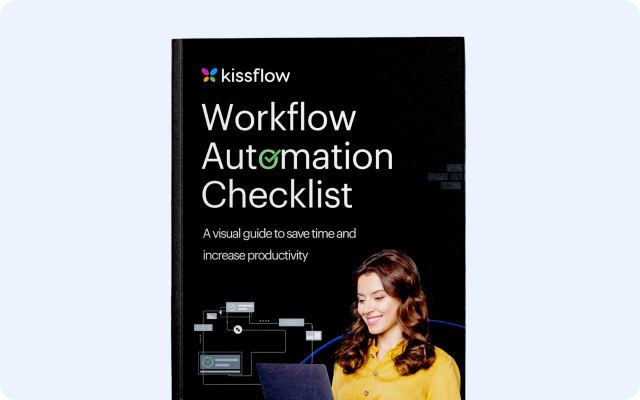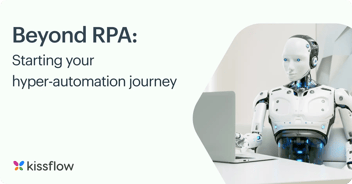
- >
- Workflow>
- Integrating AI in Hyperautomation
Integrating AI in Hyperautomation: Transforming Your Workflow
From automation to actual intelligence
I've watched countless companies automate themselves into corners. They implement rules-based workflows that work beautifully until they don't. One exception crashes the entire process. A vendor changes their invoice format, and suddenly your automation pipeline is backed up for weeks.
Here's the truth: traditional automation is brittle. It's like teaching someone to follow a recipe exactly, but never teaching them to cook.
AI changes everything. When you integrate artificial intelligence into hyperautomation, your workflows don't just run faster, they get smarter. They learn from exceptions. They predict bottlenecks before they happen. They adapt when conditions change.
Consider this: Gartner predicts that organizations combining hyperautomation technologies with redesigned processes will lower operational costs by 30% by 2024. But here's the kicker: that 30% isn't just about speed. It's about making better decisions at scale.
In platforms like Kissflow, AI isn't some flashy add-on you'll never use. It works quietly in the background, eliminating unnecessary steps, routing work intelligently, and continuously learning from how your team actually works.
Why AI isn't optional anymore
Look, I get it. "AI-powered" has become marketing speak. Every vendor slaps it on their feature list. But here's what's actually happening in the market:
The hyperautomation software market hit $720 billion in 2023, and it's not slowing down. More importantly, 65% of organizations that deployed automation have already introduced AI capabilities like machine learning, NLP, and intelligent document processing.
Why? Because automation without intelligence hits a ceiling fast. You can automate 70% of a process, but that last 30% (the judgment calls, the unstructured data, the context-dependent decisions) is where traditional automation falls apart.
AI bridges that gap by enabling:
- Context-aware decisions instead of blind rule-following
- Data extraction from messy, real-world documents (not just clean spreadsheets)
- Predictive analytics that spot problems before they become fires
- Continuous learning that makes your workflows smarter over time
In other words, AI ensures your automation doesn't just work—it improves.
Where AI actually matters in daily work
Let's cut through the hype and talk about real use cases. Here's where AI makes a tangible difference:
1. Turning document chaos into clean data
Your team receives invoices in PDFs, scans, emails, Word docs—basically every format except the one you need. Manually entering this data? Soul-crushing and error-prone.
AI solution in action:
The intelligent document processing (IDP) market grew from $1.82 billion in 2023 to $2.30 billion in 2024, and it's projected to hit $12.35 billion by 2030. Why? Because companies are tired of humans squinting at invoices.
With Kissflow, AI reads invoices regardless of format, extracts the data you need, cross-checks it against your ERP, and flags anything suspicious (duplicates, mismatches, or anomalies) before a human ever sees it.
Real impact:
- Finance teams spend 80% less time on data entry
- Error rates drop dramatically
- Approval cycles that took days now take hours
2. Smart routing that actually works
Most routing logic is painfully simple: "If X, then Y." But real work isn't that clean. A customer support ticket about a "billing issue" might actually need engineering, not finance. An expense claim that looks routine might be part of a fraud pattern.
AI sees patterns humans miss:
When 53% of businesses have already implemented RPA, the differentiator isn't automation—it's intelligence. AI analyzes ticket sentiment, historical resolution data, and current team capacity to route work optimally.
In customer support, this means:
- AI assigns tickets to the person most likely to resolve them quickly
- Low-risk, repeatable issues get auto-resolved
- Your SLA compliance improves without hiring more people
3. Workload balancing that prevents burnout
Ever notice how certain team members always seem overloaded while others have capacity? Traditional assignment logic can't see this. AI can.
Kissflow's approach:
AI looks at completion rates, current workload, historical performance, and even time-of-day patterns. In a loan origination workflow, it doesn't just assign randomly—it recommends the loan officer who's most likely to approve accurately and quickly, while balancing the team's overall workload.
The result? No more bottlenecks at Jessica's desk while Tom's twiddling his thumbs.
4. Process X-ray vision
After your workflow runs for 30 days, AI analyzes the data and tells you things like: "This approval step adds 3 days on average but changes the outcome in only 2% of cases. Consider removing it."
That's not just reporting—that's insight you can act on.
According to Gartner, by 2024, 69% of routine work currently done by managers will be automated. But the real value isn't replacing managers. It's giving them data to make better decisions.
How Kissflow integrates AI into your workflow DNA
Most platforms treat AI like a separate module you have to configure. Kissflow weaves it into the fabric of how workflows actually work:
During form design
AI suggests fields based on what similar processes use. If you're building an expense reimbursement form, AI knows you probably need receipt upload, amount, category, and date. This saves you from starting with a blank canvas.
During process creation
AI proposes routing logic based on industry best practices. Building a leave approval process? AI suggests escalation paths and approval hierarchies that actually make sense.
During execution
- AI performs sentiment analysis on communication logs (catching frustrated customers before they churn)
- Flags outliers in process behavior (identifying when something's going wrong)
- Identifies compliance risks automatically (before auditors do)
In analytics
- Generates predictive reports (showing you problems before they're problems)
- Detects anomalies in workflow metrics (spotting trends you'd miss in raw data)
- Suggests automation opportunities based on actual usage patterns
This isn't AI for AI's sake. It's AI that makes your workflows continuously better.
Where AI drives the biggest wins by department
Kissflow focuses on solving those internal application backlogs that bog down HR, procurement, finance, and IT. Here's where AI creates measurable impact:
HR workflows
- Resume parsing: Over 50% of IDP solutions now incorporate advanced AI and NLP features for understanding complex documents
- Sentiment analysis: Identify flight risks in employee surveys before they resign
- Predictive attrition: Flag likely departures 6 months in advance
Procurement workflows
- Vendor risk scoring: AI learns from performance history to predict reliability
- Auto-matching: Cross-reference POs, invoices, and delivery confirmations instantly
- Anomaly detection: Catch pricing irregularities across thousands of line items
Finance workflows
- Fraud detection: AI spots unusual patterns in expense claims and reimbursements
- Payment delay forecasting: Predict which vendors will pay late based on historical behavior
- Intelligent allocation: Automatically categorize expenses with 95%+ accuracy
IT and helpdesk workflows
- Ticket volume prediction: AI forecasts demand spikes so you can staff appropriately
- Solution suggestions: Auto-recommend fixes for common issues
- Smart escalation: Route complex issues to specialists without human triage
In each case, AI enhances the decision layer—turning automation from a task-replicator into an intelligence amplifier.
AI + Low-code: The combination that actually works
AI alone doesn't deliver value. You need it embedded in a system people can actually use and modify. That's where Kissflow's low-code platform comes in.
The global low-code development platform market hit $28.75 billion in 2024 and is projected to reach $264.40 billion by 2032, growing at 32.2% annually. Why? Because IT can't build everything, and business teams are tired of waiting.
Kissflow lets you:
- Build AI-enhanced workflows without code: Use visual tools to design processes that leverage AI insights
- Customize AI decisions: Override or validate AI recommendations based on your business rules
- Maintain governance: IT teams control the framework while departments solve problems
No black boxes. No vendor lock-in. Just transparent, auditable workflows that happen to be powered by AI.
Overcoming the "AI is too hard" excuse
I hear these objections constantly:
"We don't have clean training data." Kissflow uses pre-trained AI models for common use cases. You don't need a data science team.
"We can't integrate with our legacy systems." Kissflow offers out-of-the-box connectors for the systems you already use.
"AI is too technical for our team." Kissflow's AI features are configured through UI, not code. If you can use Trello, you can use this.
"We need explainability and governance." AI decisions are logged, reviewable, and can require human approval at any point you choose.
The result: You adopt AI in workflows without massive infrastructure investments or hiring a team of data scientists.
What CIOs should ask before scaling AI
Before you go all-in on AI-driven hyperautomation, evaluate these four factors:
- Workflow maturity Are your processes well-defined and stable enough to benefit from AI? If you're still figuring out what the process should be, start there first.
- Data availability Do you have structured and semi-structured data that AI can learn from? 50% of organizations are expected to embrace modern data quality solutions by 2024, making this the right time to get serious about data.
- Change management Have you prepared teams to trust AI-driven decisions while maintaining oversight? Only 17% of organizations face employee resistance when piloting RPA, suggesting people are ready—if you frame it right.
- Platform readiness Does your workflow automation platform support AI features natively? Or are you looking at expensive custom integrations?
If you're checking most of these boxes, it's time to move beyond simple automation and embrace intelligent hyperautomation platform like Kissflow.
The bottom line
AI isn't an optional add-on in modern automation—it's the multiplier. It transforms workflows from rigid rule-followers into adaptive systems that learn, optimize, and scale.
The market agrees: For the third year in a row, 80% of Gartner clients report they will increase or sustain hyperautomation spending. Those who wait are falling behind.
When integrated into a platform like Kissflow, AI becomes practical, accessible, and impactful. Whether you're looking to reduce delays, improve accuracy, or enhance user experience, AI is the catalyst.
Combined with Kissflow's low-code environment, your automation initiatives aren't just faster—they're smarter.
Ready to see AI-powered workflows in action?

Checkout Kissflow's Workflow Automation Checklist
Thank you for downloading the ebook!
Related Articles











